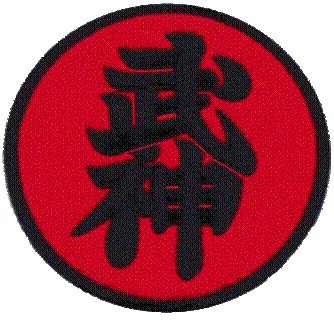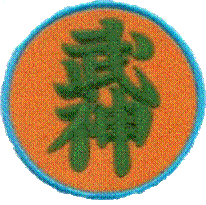
武
神
館
武
徳
道
場
武
神
館
武
徳
道
場
© rOcO 2014




BUJINKAN RANKING SYSTEM
In the Bujinkan Dojo students are periodically promoted as a reward for their progress, efforts, sweat and blood, and their dedication. Contrary to most martial arts Bujinkan's Grandmaster, Hatsumi Sensei, says there are no specific requirements or techniques that are needed to be learned for any particular level of promotion. This is very different than virtually all other martial arts and emphasizes our focus on "real technical skill" and not just "technique memorization" as is the case with almost all other martial arts.
The "technical skills" that we learn are really the "threads" that connect each and every technique together. In the Bujinkan we work on many different techniques and countless variations on each of them, even with our beginning students. Our students focus on things like the "management" of timing, distance, balance, leverage, proper body movement and similar principles by practicing many different techniques all the time, and not by doing the exact same techniques over and over again, and in a "mirror" image of the instructor.
We at the Bujinkan Butoku Dojo follow Hatsumi Sensei's guidelines in this matter and do not have a "set curriculum" for students to learn, although other Bujinkan instructors have very specific techniques for each level f promotion. Some Dojo have a very specific and detailed curriculum for each promotion. This "checklist" is fine, but please keep in mind that these guidelines for promotion are those of the Dojo's instructor, and not by Grandmaster Masaaki Hatsumi. Based on how Hatsumi Sensei teaches, and how he suggests that we do too, we believe there are good reasons for NOT teaching by a set curriculum, so we teach in a similar manner to Grandmaster Masaaki Hatsumi.
In the Bujinkan Butoku Dojo each student is promoted based on three areas that are constantly evaluated. This evaluation is performed by the Primary Instructor and the Dojo's black belts, in order to arrive at an honest and unbiased "group consensus." All promotions in our Dojo should be looked at as recognition for one's "personal progress and improvement" and not used to compare one person to another, even if they have the same rank. As everyone knows, each person has their own individual strengths and weaknesses. Students are promoted based on their "personal" progress, and not on the progress, or lack of progress, of their peers. Each student is evaluated on the following areas:
Overall Technique and Skill Application (of skills learned so far)
Ability to fill in the very important "details" of their techniques
Overall personal character and disposition towards fellow students, instructors, and society in general.
After a student is promoted he or she receives a certificate for their new rank. Students receive "official" certificates are that are issued by Masaaki Hatsumi, Grandmaster of the Bujinkan System. Hatsumi Sensei has clearly stated that only certificates issued by the Hombu Dojo are valid, and we strictly follow this rule. According to Hatsumi Sensei, certificates not issued directly by him are not allowed, by any instructor. Please note that some instructors do not follow Hatsumi Sensei's rules on the issuing of certificates. Hatsumi Sensei has specifically stated that "fake" certificates are not valid!
Promotions - A Historical Perspective
Historically Japanese martial arts have had a number of different ways of promoting or ranking students. Originally there was no ranking system at all, everyone just trained and learned together, as a very close knit group. Later, a three (3) tier system of Shoden (low / beginner), Chuden (middle / intermediate), Jodan (high / advanced) was probably the next progression from the original "no promotion" system. Sometimes this three tier system had a forth Hiden (hidden) tier that contained secrets that were passed on only by Kuden (oral tradition) to a few select students. Of course the actual Japanese words used for these subdivisions could have been different than those used in the above illustration, but the overall structure is the same.
As time passed, the dan system came into being, along with different colored belts signifying various levels of rank. This "colored belt system" is reported to have been directly influenced by the bureaucratic system of the Heian culture in Japan, and that was copied from the Sui dynasty of China, of the same time period. This is a more formalized and complicated system of promotions, and is still in common practice today with most martial arts, Japanese and otherwise. It is interesting to note that a number of qualified authors of recent times have suggested that the current methods of promotions seem to be more geared towards "institutional formalism and organizational requirements" of the martial arts then with the learning of the true essence of martial arts - The techniques.
The Bujinkan Ranking System
In the Bujinkan Dojo, Obi (belts) are worn to provide a very broad based, or general idea of a person's skill level. Hatsumi Sensei has indicated that only three (3) colors of belts be used in the Bujinkan. Those colors are white, green, and black. Each color belt except for white has several different levels or steps. This three (3) color belt system is used exclusively in all Japanese Bujinkan Dojo, but it is not standard in some Bujinkan Dojo in the US and abroad.
Some non-Japanese Dojo have, for one reason or another, decided to add additional colors to Hatsumi Sensei's system of promotions. Some have added a brown belt level to replace the traditional higher level green belt, and yet others have added a wide variety of colors. It is the belief of everyone at the Bujinkan Butoku Dojo that there is no reason for additional colors, for it simply further "segregates" people into rank based categories. Our real goal should be to make everyone friends and training partners or the highest quality, and not divide everyone into a nice need subgroups. Why should be add additional barriers (more belt colors) that separate students from each other. One should be striving to unite out students into a "close knit family". Of course some have argued that additional colors assist the "beginners" in knowing who to ask when they are having problems. This seems like a perfectly reasonable answer, but it has been found that beginners don't need a "belt beacon" to tell them who to seek with questions. They can usually figure this out in a very few classes. In our Dojo the primary instructor is always on the training floor and available, there are usually a number of highly qualified black belts in each class too. Most of our green belts are capable enough to answer many questions, of course sometimes they just don't realize it.
A "white belt", or Mu Kyu (no Kyu, or rank) is simply someone whom has not yet been promoted in the Bujinkan system. Usually they are persons just starting their training. As a general rule persons are white belts for the first 2 or 3 months of their training, after which they are promoted to the first level of green belt.
A "green belt" indicates that one is basically a beginner and working to learn the core material of this art. There are nine (9) different levels of green belt. The lowest level is 9th Kyu (pronounced "Q") and the highest is 1st Kyu. Kyu means "class" in Japanese. As each student advances through the various levels of green belt they learn more and more of the fundamental principles that underlie all of the Bujinkan training. After passing through each of the Kyû levels one reaches the Dan, or black belt, level.
The first level of black belt is called Shodan and we feel that at this level one has finally grasped the "basic skills" of the Bujinkan, and is now ready to really begin their learning! Now is the time for one to take the vast skills and knowledge they have learned so far and begin to use those "basics" in more advanced levels. This is also the time to really mix the basics together into new skills, and to learn more advanced techniques too. Of course all of these things are taught while persons are in the green belt stages of their training, but by black belt these skills are really beginning to come together and their training really progresses even faster then before.
Contrary to many other styles of martial arts, in the Bujinkan, one's training has really just begun at the level of black belt. This does not mean that new black belts have not learned much up to this point, but at this point most students have now finally learned the "basics" well enough to really begin to grow in leaps and bounds. It's like a farmer preparing a field for planting, a lot of work has to go into the process of "preparing the soil" before even one seed can be planted.
There are fifteen (15) levels of black belt in the Bujinkan. After one achieves the level of Yon Dan (fourth Dan), Hatsumi Sensei is the only person within the Bujinkan that can promote someone to higher Dan levels. After passing the Godan (5th Dan) test (administered by Hatsumi Sensei) he is the only person that can promote this student to higher levels of black belt. Recently, Hatsumi Sensei has also been promoting persons based on recommendations from Senior Instructors that are Judan (10th Dan) and higher. As the size of the Bujinkan increases it becomes harder and harder for Hatsumi Sensei to follow the progress of each and every mid to upper level black belt, so he has been seeking assistance from his Senior Instructors in this matter.
Hatsumi Sensei has also divided the Black belts into three (3) larger subcategories that are listed below.
Shodan (1st)
Nidan (2nd)
Sandan (3rd)
Yondan (4th)
Godan (5th)
Rokudan (6th)
Nanadan (7th)
Hachidan (8th)
Kudan (9th)
Judan (10th)
Chi - Earth ( 11th)
Sui - Water ( 12th)
Ka - Fire ( 13th)
Fu - Wind ( 14th)
Ku - Void ( 15th)
Bujinkan Badges (Patches)
In the Bujinkan, students are encouraged to wear the "Bujin" (Divine Warrior) patch on their Gi. There are actually four (4) different styles of this Bujin patch. The specific style of patch worn is determined by one's rank. A Kyû patch is worn by green belts. A Dan patch is worn by persons from Shodan to Yondan (1st through 4th level black belt). A Shidoshi patch is worn by persons from Godan to Kudan (5th through 9th Dan). And finally, the Shihan patch is worn by persons at Judan or above (10th through 15 Dan). "Technically" gold or silver stars are used in conjunction with the various patches to indicate of one's exact rank. While most Bujinkan Dojo provide patches with promotions, not all of them actually use the stars.
9th Kyu (no stars)
8th Kyu (1 silver star)
7th Kyu (2 silver stars)
6th Kyu (3 silver stars)
5th Kyu (4 silver stars
4th Kyu (1 gold star)
3rd Kyu (2 gold stars)
2nd Kyu (3 gold stars)
1st Kyu (4 gold stars)
1st Dan (no stars)
2nd Dan (1 silver star)
3rd Dan (2 silver stars)
4th Dan (3 silver stars)
5th Dan (no stars)
6th Dan (1 gold star)
7th Dan (2 gold stars)
8th Dan (3 gold stars)
9th Dan (4 gold stars)
10th Dan (no stars)
11th Dan - Chi (1 gold star)
12th Dan - Sui (2 gold stars)
13th Dan - Ka (3 gold stars)
14th Dan - Fu (4 gold stars)
15th Dan - Ku (5 gold stars)
Dai Shihan



Bujinkan Butoku Dojo
traditional applications for modern situations